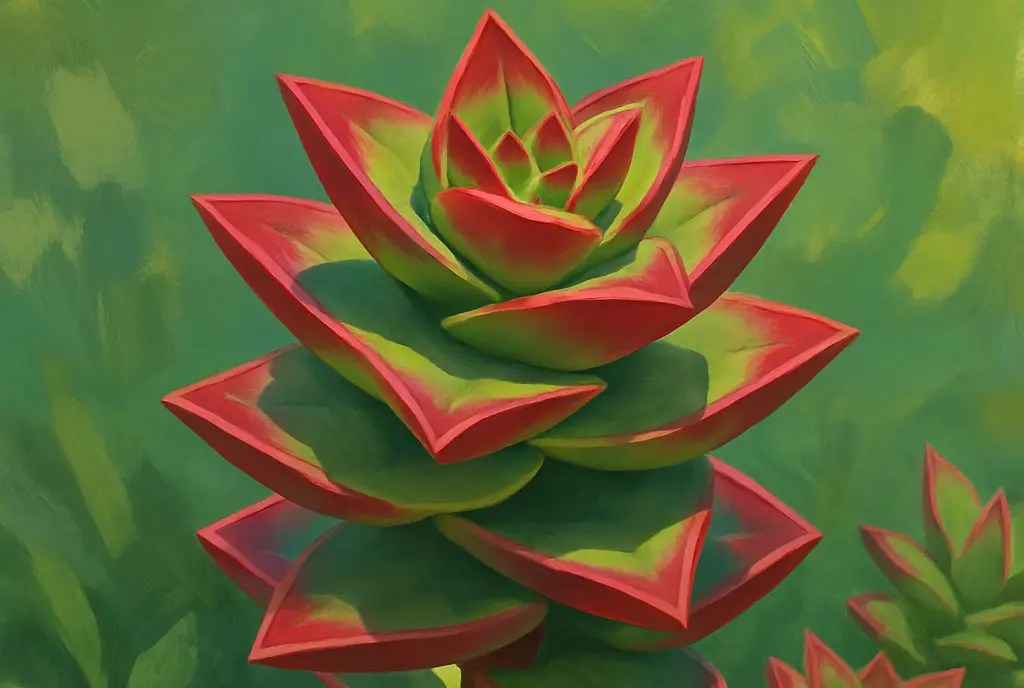Crassula Red Pagoda: A Unique Succulent for the Garden
Introduction
Are you looking for a striking and easy-to-grow succulent to add to your collection? Look no further than Crassula Red Pagoda, a captivating plant that will add architectural interest and a pop of color to any garden or indoor space.
Architectural Wonder
Crassula Red Pagoda is known for its unique and eye-catching triangular foliage. The stacked, triangular leaves are arranged in a spiral pattern, resembling a pagoda or shark’s tooth. The edges of the leaves are adorned with fine, prickly spines, adding to the plant’s architectural charm.
Color and Illumination
Red Pagoda’s foliage is not only distinctive in shape but also vibrant in color. When exposed to bright sunlight, the leaves develop hues of deep red, pink, or orange. The geometric arrangement of the leaves creates an optical illusion, making it seem like you’re looking into a deeply hued, ribbed tunnel.
Growing Conditions
Despite its exotic appearance, Crassula Red Pagoda is surprisingly easy to grow. It prefers well-drained soil with plenty of grit, but it can also survive in amended clay soil. Red Pagoda is hardy in USDA zones 11 to 12 but thrives as a houseplant in cooler climates.
Planting and Propagation
Red Pagoda can be grown from cuttings or seeds. To propagate from cuttings, simply take a healthy stem cutting, allow it to callus over for a few days, and then insert it into a soilless medium. In about a month, the cutting will root and can be transplanted into a container or the garden.
Care and Maintenance
Red Pagoda has low water needs, but it’s important to establish a regular watering schedule, especially during the first year, to encourage a vigorous root system. The plant prefers full or partial sun and can withstand short periods of drought. It’s also deer and rabbit resistant, making it a low-maintenance choice for gardens.
Troubleshooting
The most common problem with Crassula Red Pagoda is overwatering, which can lead to root rot. Other potential issues include mealybugs and aphids, which can be controlled with insecticidal soap or neem oil. Removing spent leaves will help maintain the plant’s best appearance.
Long-Tail Keyword-Specific Content
- How to grow Crassula Red Pagoda in containers: Red Pagoda is well-suited for growing in containers, especially hanging baskets. Ensure the container has drainage holes and use a well-draining potting mix.
- Growing Red Pagoda succulents from cuttings: Taking cuttings is an easy and effective way to propagate Red Pagoda. Use sharp, clean shears to take a stem cutting and follow the steps outlined above.
- Best soil for Crassula Red Pagoda: Red Pagoda prefers well-drained soil with plenty of grit. You can amend clay soil with perlite or pumice to improve drainage.
- Ideal location for Crassula Red Pagoda plants: Red Pagoda prefers full or partial sun and well-drained soil. In colder climates, it can be grown as a houseplant in a south-facing window.
- Care tips for Crassula Red Pagoda succulents: Red Pagoda has low water needs and can withstand short periods of drought. Water only when the soil is completely dry to the touch.
- Troubleshooting problems with Red Pagoda succulents: Overwatering is the most common problem with Red Pagoda. If you notice yellowing or wilting leaves, reduce watering frequency. Mealybugs and aphids can also be a problem; treat with insecticidal soap or neem oil.
Conclusion
Crassula Red Pagoda is a captivating succulent that adds architectural interest, vibrant color, and low-maintenance beauty to any garden or indoor space. Its unique triangular foliage, ease of care, and drought tolerance make it an excellent choice for both beginner and experienced gardeners alike.
